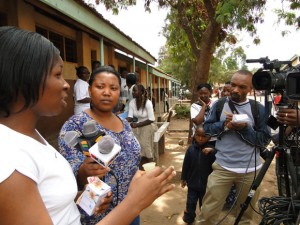
Rhoune Ochako, a research officer at APHRC, explains how the cup works in this photo from the APHRC web site.
At re:Cycling, we’re interested in all kinds of menstruation and women’s health issues, all over the world. We have written several times about the need for menstrual pads for girls and women in developing nations, like the Kasissi Project Girls Program producing M.A.K.A. pads in Uganda and Sustainable Health Enterprises making pads from banana trees for women in Rwanda, and LunaPads’ Pads4Girls program, which collects and donates reusable pads to girls in several African nations as well as Mexico and South America. We’ve also suggested that cramps and menstrual pain may cause girls to miss school as much as lack of menstrual supplies.
So it was with great interest that we read about a new pilot program of the African Population and Health Research Center (APHRC) that will distribute menstrual cups to girls in Nairobi.
Women and girls in Korogocho slums have been identified who will use the cup for up to four months, after which they will be interviewed about their experiences,” explained Rhoune Ochako, a research officer at APHRC.
The study will also assess acceptability of the cup, as many girls were intimidated to use the cup. A teacher at Our Lady of Fatima Secondary school initially queried 400 students, of whom only three were willing to participate in the study.
Celestine Awino [age 17] is among girls who agreed to participate in the project that started about a year and a half ago and has been using the cup since then. “At first I was afraid. I waited until a friend used it, then I tried. I have now been using it for over ten months,” she says.
Awino says she is able to engage in school activities during her periods while wearing the cup. “I take part in sports, cleaning and learning activities without any problem. It is better than missing school because one lacks sanitary pads,” she says.
Given the economic and environmental advantages of menstrual cups (not to mention their reliability), this experiment has great potential to make a big difference.

